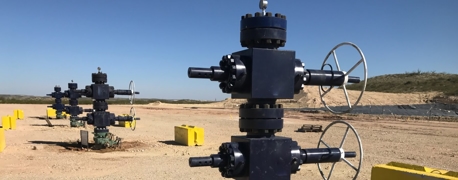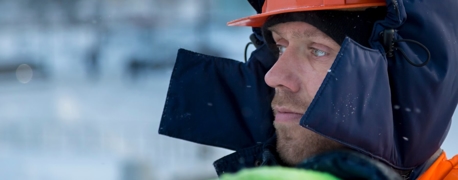Why Do Oil Rigs Winterize? 6 Real Dangers for Rig Workers

Depending on their location and just how far temperatures drop, offshore oil rigs and land rigs can keep functioning through the winter. Keeping rigs operational is an essential part of maintaining the country’s entire energy infrastructure. To make this as safe as possible, however, they must be winterized. This is a process where an oil rig is prepared for cold weather. When done right, winterization can protect workers, equipment, and production. It can keep rigs working so they can supply oil and gas to plants and refineries across the U.S.
When winterization is glossed over, delayed, or outright ignored, the results can be catastrophic.
Why Is Winterization So Important?
Offshore land rigs, oilfields, power plants, and oil refineries cannot simply cease operations for several months out of the year. They must adapt to changing weather through proper winterization. When they don’t, disaster can strike. That’s what happened at the DuPont pesticide plant in LaPorte, Texas in November 2014. Four workers lost their lives because pipes at the plant were not properly protected from the cold, leading to a deadly chemical release.
In addition to threatening workers’ lives and the environment, improper or failed winterization of oil rigs can impact millions of people by cutting off their power supply. In February 2021, millions of Texans were left without power because the state’s power plants – and the natural gas facilities that support about half of them – were not properly protected against the cold. While the Arctic cold front that passed through southeast Texas brought unprecedented low temperatures, snow, and sleet, the oilfields and plants should have had measures in place to ensure they could stay operational.
At least 246 people died across 77 counties as a result of the 2021 Winter Outbreak in Texas, spurring legislation that now requires plants to winterize. Early iterations of Senate Bill 3 had a loophole that would have allowed natural gas companies to avoid winterization rules by filing a paper and paying a fee. The loophole has since been closed, and Texas plants could face fines of $5,000 to $1 million for failing to winterize. Mandatory winterization of natural gas facilities, however, will not be mandatory until 2023. Considering that about half of Texas power plants rely on natural gas as their primary fuel, this could prove to be a critical error that puts workers and communities at risk.
Oil Rig Winterization & Winter Safety
Winter weather creates harsh conditions for oil rig equipment, piping, and instrumentation. Workers also face the risk of hypothermia, frostbite, and trench foot caused by exposure to freezing or near-freezing temperatures. When an oil rig is properly winterized and workers are given the gear and training to deal with the cold, the risks can be lowered significantly.
Winterizing an oil rig may include the following steps:
- Planning – Companies must create detailed plans and checklists of every piece of equipment, instrument, pipe, and system that needs to be retrofitted for the cold. These plans must also outline exactly what to do if something goes wrong.
- Training – Every single worker on an oil rig must be trained on how to work in cold weather, what gear to wear, how to handle winterized equipment, and the freezing points of every material they deal with.
- Insulating – Proper insulation will reduce heat loss and will protect equipment, machinery, and instrumentation from the damaging effects of the cold. Outdoor equipment and piping must also be protected, with plans in place if a blockage, freeze, or leak occurs.
- Maintaining – Maintenance is even more crucial during cold winter months, as low temperatures and significant temperature changes can put additional pressure on heavy machinery, instruments, pipes, and other equipment.
- Slowing Down – Rushing any task on an oil rig is a dangerous idea. In the winter, workers should be particularly cognizant of the value of taking extra caution, walking slowly to avoid slipping on ice, checking equipment carefully in freezing temperatures, and more.
If temperatures are expected to drop too low or a storm is coming in, however, staying operational is not an option. In some cases, a well may need to be temporarily shut down in preparation for a freeze. In others, fixed rigs may need to be evacuated. Floating rigs may need to be moved to warmer waters.
When Rig Winterization Goes Wrong
Winterizing oil rigs is in the best interests of owners and operators, as production can continue and serious accidents can be avoided, but that doesn’t necessarily mean that they will do the right thing. In attempts to avoid shutdowns and the cost of replacing or maintaining equipment, some oil and gas companies may delay winterization, continue to work with aging equipment, or cut corners in educating and implementing workers on winter safety. Nothing good can come of this.
Oil rig workers face six main dangers when companies do not prepare for winter temperatures:
Danger #1: Faulty Instrumentation
Extreme cold or the combination of hot and cold temperatures can lead to condensation in critical instrumentation. Sensors may malfunction and signals may be interrupted, affecting readings that give rig operators the information they need to drill and extract natural gas. If instrumentation is improperly winterized or is not prepared for low temperatures at all, blowouts, leaks, and other serious accidents may occur.
Bad instrumentation results played a role in one of the most famous disasters of the 21st century: the BP Deepwater Horizon explosion. One NPR report from 2011 describes how rig operators “didn’t like a reading,” so they tested again with another instrument and got a favorable result. That favorable result provided false reassurance, which continued the chain of events that led to the blowout explosion.
Accurate readings, particularly pressure readings, are the difference between normal operation and complete disaster. If cold temperatures can affect the legibility or accuracy of a rig’s instruments, that’s a serious problem.
Danger #2: Frozen Piping
Frozen piping is one of the primary hazards associated with cold temperatures. Water and other materials will expand if they freeze in pipes, and in some cases, water may mix with other substances to form solid hydrates, which can block piping. Frozen pipes may leak or crack. Removing a blockage in piping can be dangerous in itself. Improperly winterized piping and equipment on an oil rig can cause catastrophic explosions, fires, and other accidents.
The danger of frozen pipes isn’t always immediate, either. A poorly winterized rig’s pipes will experience daily cycles of thawing and freezing, weakening the pipes every time. This cyclical stress can exacerbate the wear and tear on the piping material, leading to what is known as freeze-thaw fatigue. Each freeze cycle can cause minute cracks to form and expand in the piping. As the temperature fluctuates and the material contracts and expands, these cracks can grow, compromising the integrity of the pipes.
This gradual deterioration is particularly dangerous because it can go unnoticed for a long period. Unlike a sudden rupture or leak, which might be immediately evident and trigger a rapid response, the slow process of freeze-thaw weakening can lead to a sudden and unexpected failure at a later stage. When such a failure occurs, it often does so catastrophically, as the compromised pipe might give way under high pressure, leading to a significant release of oil, gas, or other hazardous substances.
Danger #3: Cold Stress Injuries
When oil rig workers are not adequately protected against the harsh realities of winter weather, they face a significantly increased risk of cold stress injuries. This risk is particularly acute on offshore rigs and in oilfields where workers are exposed not only to low temperatures but also to additional chilling factors like wind, rain, or sea spray. These conditions can rapidly draw heat away from the body, exacerbating the risk of cold-related health issues.
One of the common cold stress injuries is trench foot, also known as immersion foot. This condition arises when feet are exposed to wet and cold conditions for prolonged periods. Unlike frostbite, which affects body parts exposed to freezing temperatures, trench foot can occur at temperatures as high as 60°F if the feet are constantly wet. It results in swelling, numbness, and blistering, and can lead to severe infections if untreated. In the unique environment of an oil rig, where workers often stand for long hours in wet conditions, the risk of trench foot is significantly heightened.
Danger #4: Ice, Snow & Slippery Decks
On a land rig or an offshore platform, ice and snow can make walkways, ladders, and stairs extremely hazardous. Without proper winterization, these surfaces can cause slip and fall accidents and even falls overboard that leave workers seriously injured or even claim their lives.
Falls on a land-based oil rig or in the oilfield, particularly under icy and snowy conditions, are a significant safety concern and can lead to particularly severe injuries. The nature of oil rig operations involves working at heights, on uneven surfaces, and around heavy machinery. When surfaces like walkways, ladders, and stairs become slick due to ice and snow, the risk of a fall increases exponentially.
Injuries resulting from falls in these environments can be especially grievous due to:
- Height and impact
- Proximity to hazardous equipment
- Exposure to chemicals
- Cold exposure
Danger #5: Equipment Failure
Inadequate winterization on oil rigs can lead to a variety of equipment failures in cold and freezing temperatures. The viscosity changes in lubricants and hydraulic fluids in low temperatures can impede their circulation, increasing friction and wear, which might cause machinery to seize up unexpectedly. Similarly, batteries become less efficient in the cold, posing a significant risk, especially for emergency equipment which might fail to operate when needed.
The contraction of materials in cold weather can lead to misalignments in machinery, and repeated temperature fluctuations can cause metal fatigue, increasing the risk of critical components breaking. Seals and gaskets also become brittle in the cold, leading to potential leaks in hydraulic systems and pipelines, which can impede operations and pose environmental hazards.
Electronic components and control systems are also susceptible to cold weather, potentially leading to malfunctions in vital monitoring and control equipment. This can result in incorrect operational readings or failure to detect hazardous conditions. Moreover, ice and snow accumulation can physically obstruct moving parts, disrupt sensor functions, and add extra weight to structures, potentially leading to imbalance or structural failure.
Danger #6: Blowouts & Other Disasters
The worst oil and gas disasters happen when companies cut corners in maintaining equipment and implementing safety standards. This applies to winterization as well. It also applies to companies’ overall behavior when storms are about to strike, such as failing to evacuate crews from rigs or oilfields in areas that are going to be hit by heavy winter storms. Oil rig explosions, capsizing platforms, fires, and other catastrophes can be linked to failures to prepare for winter weather.
Rig Workers Deserve Safe Work Environments, Even in the Winter
It doesn’t matter how hot or how cold it gets. It doesn’t matter if a storm is rolling in. Oil rig workers deserve to be protected from the worst that Mother Nature has to offer, and in the winter, that means proper rig winterization. Texas has made steps in the right direction with legislation that requires plants and soon natural gas facilities to winterize. It’s time for all rigs, plants, and oil and gas facilities to prioritize winterization – before temperatures drop.
- Categories


